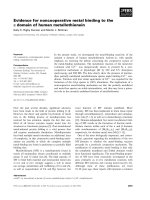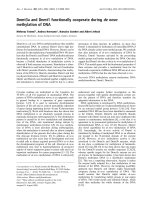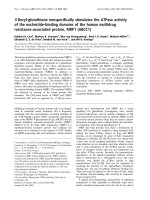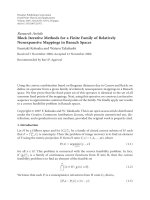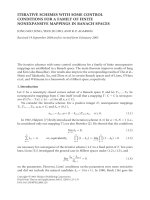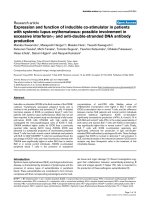Báo cáo y học: " Potent and persistent antibody responses against the receptor-binding domain of SARS-CoV spike protein in recovered patients" doc
Bạn đang xem bản rút gọn của tài liệu. Xem và tải ngay bản đầy đủ của tài liệu tại đây (567.9 KB, 6 trang )
RESEA R C H Open Access
Potent and persistent antibody responses against
the receptor-binding domain of SARS-CoV spike
protein in recovered patients
Zhiliang Cao
1†
, Lifeng Liu
2†
, Lanying Du
3
, Chao Zhang
1
, Shibo Jiang
3
, Taisheng Li
2*
, Yuxian He
1*
Abstract
Background: The spike (S) protein of SARS-CoV not only mediates receptor-binding but also induces neutralizing
antibodies. We previously identified the receptor-binding domain (RBD) of S protein as a major target of
neutralizing antibodies in animal models and thus proposed a RBD-based vaccine. However, the antigenicity and
immunogenicity of RBD in humans need to be characterized.
Results: Two panels of serum samples from recovered SARS patients were included and the antibody responses
against the RBD were measured by ELISA and micro-neutralization assays. We found that the RBD of S protein induced
potent antibody responses in the recovered SARS patients and RBD-specific antibodies could persist at high titers over
three year follow-up. Furthermore, affinity purified anti-RBD antibodies possessed robust neutralizing activity.
Conclusion: The RBD of SARS-CoV is highly immunogenic in humans and mediates protective responses and RBD-
based vaccines and diagnostic approaches can be further developed.
Background
The global outbreak of severe acute respiratory syn-
drome(SARS),causedbyanovel coronavirus (SARS-
CoV), resulted in m ore than 8,000 cases with a fata lity
rate of about 10%. Impressively, the rapid spread of
SARS-CoV made a great impact on public health and
social-economic stability. It is thought that SARS-CoV
might originate from its natural reservoir bats and trans-
mit to humans through an intermediate such as palm
civets and raccoon dogs, and no one can exclude the
possibility of its recurrence [1].
SARS-CoV is an enveloped positive-stranded RNA
virus and its “ crown"-like spike (S) protein has two
major biological functions: 1) mediating receptor (angio-
tensin converting enzyme 2, ACE2) binding and mem-
brane fusion; 2) inducing neutralizing antibody
responses [2,3]. The S protein was considered as an
important target for developing diagnostics, vaccines
and therapeutics [4-12]. The receptor-binding domain
(RBD) of S protein was defined as a fragment corre-
sponding to the residues 318 - 510 of the S protein,
which mediates viral binding to cell receptor ACE2
[13-15]. Coincidently, we identified the RBD as a major
target of neutralizing antibodies [16-19], and proposed it
as an ideal vaccine antigen for clinical application
[20-22]. The immunogenicity and protective e fficacy of
RBD-based vaccine candidates have been evalua ted in
animal models [17,23-25]. However, the antigenici ty and
immunogenicity of RBD in humans need to be charac-
terized in detail toward developing the RBD-based vac-
cines and diagnostics. In this short commu nicatio n, we
found that patients recovered from SARS developed
potent and persistent R BD-specific antibody responses,
highlighting the potentials of clinical applications of
RBD-based vaccines and diagnostics.
Materials and methods
Serum samples from SARS patients
Two panels of serum samples from the recov ered SARS
patients were used in this study. The first panel of 35
samples were leftover from the previous study [12],
* Correspondence: ;
† Contributed equally
1
State Key Laboratory for Molecular Virology and Genetic Engineering,
Institute of Pathogen Biology, Chinese Academy of Medical Sciences and
Peking Union Medical College, Beijing 100730, China
2
Peking Union Medical college Hospital, Chinese Academy of Medical
Sciences and Peking Union Medical College, Beijing 100730, China
Full list of author information is available at the end of the article
Cao et al. Virology Journal 2010, 7:299
/>© 2010 Cao et al; licensee BioMed Central Ltd. This is an Open Access article distributed under the terms of the Creative Commons
Attribu tion License ( which permits unrestricted use, distribution, and rep rodu ction in
any medium, provided the original work is properly cited.
which were collected from the convalescent-phase SARS
patients 30-60 days after onset of illness during the
2003 outbreak in Beijing. The second panel of sequential
samples were collected from 19 SARS patients, who
were enrolled in March 2003 for a follow-up study at
the Peking Union Medical College Hospital, Beijing. All
patients were diagnosed as SARS according to the cri-
teria released by WHO and verified to be serologically
positive by clinical laboratories. Informed consent was
obtained from each participant.
Expression of recombinant RBD proteins
The RBD-His (RBD sequence with a His-tag) and RBD-
Fc (RBD fused with human IgG-Fc) proteins were
respectively expressed and purified as described pre-
viously [16,23]. In brief, the plasmid encoding RBD-His
or RBD-Fc was t ransfected into HEK293T cells using
Lipofectamine 2000 (Invitrogen, Carlsbad, CA) accord-
ing to the manufacturer’ s protocols. Culture medium
was replaced by fresh OPTI-MEM I Reduced-Serum
Medium 12 h post-transfection and the supernatants
containing expressing RBD proteins were collected 72 h
later. RBD-His was purified by Nickel affinity column
(Qiagen), while RBD-Fc was purified by protein A-
Sepharose 4 Fast Flow (Amersham Biosciences, Piscat-
away, NJ).
ELISA
The reactivity of SARS serum samples or purified anti-
RBD antibodies with recombinant RBD protein was
determined by ELISA. Briefly, 1 μg/ml purified RBD-His
was coated onto wells of 96-well microtiter plates
(Corning Costar, Acton, MA) in 0.1 M carbonate buffer
(pH 9.6) at 4°C overnight. After blocking with 5% non-
fat milk for 2 h at 37°C, diluted samples were added and
incubated at 37°C for 1 h, followed by three washes with
PBS containing 0.1% Tween 20. Bound antibodies were
detected with HRP-conjugated goat anti-human IgG
(Invitrogen, Carlsbad, CA) at 37°C for 1 h, followed by
three washes. The reaction was visualized by addition of
the substrate 3,3’,5,5’-te trame thylbenzid ine (TMB) and
stopped by addition of 2N H
2
SO
4
. Absorbance at 450
nm was measured by ELISA Microplate Reader (Bio-
Rad, Hercules, CA). Total serum IgG antibodies against
SARS-CoV were measured using commercially available
whole virus lysates-based ELISA kits (BJI-GBI Biotech-
nology, Beijing, China).
Immunoaffinity chromatography
The immunoaffinity resin for the purification of RBD-
specific antibodies was prepared as described previously
[19]. In brief, the RBD-Fc fusion protein was coupled to
cyanogenbromide-activated Sepharose beads (Pharmacia,
Piscataway, NJ) according to the manufacturer’ s
instruction. For immunoadsorption , pati ent serum sam-
ple was diluted 10-fold wit h PBS and incubated with the
RBD-Fc resin overnight at 4°C with constant rotation.
Resin was then packed into a 5-ml column and the
flowthrough was discarded. After the resin was washed
with 10× column volumes of PBS, the bound antibodies
(anti-RBD) were eluted in 0.2 M glycine-HCl buffer, pH
2.5. The elua tes were immed iately neutralized with Tris
buffer (pH 9.0). Then, the buffer w as exchanged with
PBS by several cycles of dilution and concentrated by
Amicon Ultra-15 centrifugal filter device (Millipore Cor-
poration, Bedford, MA). The purified anti-RBD antibo-
dies were sterilized with 0.2-μmporesizemicrospin
filters (Millipore) and the concentrations were
measured.
Micro-neutralization assays
SARS pseudovirus system was developed in our labora-
tory as previously described. In brief, HEK293T cells
were co-transfected with a plasmid encoding codon-
optimized
SARS-CoV S protein (Tor2) and a plasmid
encoding Env-defective, luciferase expressing HIV-1
genome (pNL4-3.luc.RE) using Lipofectamine™ 2000
reagents (Invitrogen) according to the manufacturer’s
protocol. Supernatants containing pseudovirus bearing
the S protein were harvested 48 h post-transfection and
used for single-cycle infection of ACE2-expressing 293T
cells (293T/ACE2). Briefly, 293T/ACE2 cells were plated
(10
4
cells/well) in 96-well tissue culture plates and
grown overnight. The pseudovirus was preincubated
with serially diluted purified anti-RBD at 37°C for 1 h
before addition to cells. The c ulture was re-fed with
fresh medium 12 h later and incubated for an additional
48 h. Cells were washed with PBS and lysed using lysis
reagent included in the luciferase kit (Promega, Madi-
son, WI). Aliquots of cell lysates were transferred to 96-
well Costar flat-bottom luminometer plates (Corning
Cos tar, Corning, NY), followed by additi on of luciferase
substrate (Promega). Relative light units (RLU) were
determined immediately on the Modulus™ II Microplate
Multimode Reader (Turner Biosystems, Sunnyvale, CA).
Results
Potent RBD-specific antibody responses in SARS-CoV
infected patients
Because our previous studies indicated that the RBD of
S pro tein was a major targe t of neutralizing antibodies
andthattheRBD-basedimmunogenscouldinduce
potent neutralizing responses and protective immunity
in animal models, w e intended to know the immuno-
genicity of RBD in infected patients. A panel of 35 con-
valescent sera collected from the SARS patients 30 - 60
days after onset of illness were previously used for map-
ping the antigenic sites of SARS-CoV [12]. The leftover
Cao et al. Virology Journal 2010, 7:299
/>Page 2 of 6
samples were stored in -80°C and expected to maintain
their activities to interact with SARS-CoV antigens.
Therefore, we used the purified RBD-H is protein as a
coating antigen in ELISA to detect RBD-specific IgG
antibodies in these SARS serum samples. As shown in
Figure 1, all 35 convalescentseraat100-folddilutions
significantly reacted with the RBD-His protein with an
average OD
450
value of 1.63. As a control, none of the
sera from healthy blood donors was reactive to this anti-
gen. The results demonstrated that the S protein RBD is
highly immunogenic in the SARS-CoV infected patients.
Persistent RBD-specific antibody responses in SARS-CoV
infected patients
To study the antigenicity and immunogenicity of SARS-
CoV in humans, we enrolled a cohort during the SARS
outbreak in 2003, and 19 patients were followed-up over
three years. The sequential blood samples were collected
at month 3, 12, 18, 24, and 36, respectively, after the
onset of c linical symptom. All serum samples were
tested at 100-fold dilutions for RBD-specific IgG antibo-
dies by ELISA with RBD-His as a coating antigen. In a
parallel, total serum IgG antibo dies specific for SARS-
CoV were also detected using the commercial ELISA
kit, in which the whole virus lysates were coated as anti-
gen. The serum samples were diluted at 1:10 according
to the manufacturer’ s instruction. The results are pre-
sented in Figure 2. The RBD-specifi c antibodies main-
tain relative ly higher titers through 3 year follow-up. At
year 2 and year 3, only one same sample became unde-
tectable and thus gave a positive rate of 94.74%. How-
ever, the ELISA results from the kit showed much low
reactivity. Compared to the RBD-based results, the OD
values for all samples dropped dramatically at year 2
and 3. Specially, the positive percentage of the year 3
samples was only 42.11% (8/19), suggesting the viral
lysate-based ELISA kit h ad much low sensitivity than
the RBD-based ELISA.
RBD-specific human antibodies possess potent
neutralizing activity
We and others previously reported that RBD-specific
polyclonal and monoclonal antibodies had potent neu-
tralizing activity against SARS-CoV infection in vitro
and in vivo [16,17,26,27]. We have kept asking whether
RBD-specific antibodies are responsible for serum-
mediated neutralizing activity.Tothisend,wepurified
RBD-specific antibodies
by immunoaffinity chromato-
graphy from four SARS serum samples selected from
the convalescent-phase SARS patients 30-60 days after
Figure 1 Potent RBD-specific antibody responses in the
recovered SARS patients. The convalescent sera from 30 SARS
patients and normal sera from 25 healthy blood donors were tested
at 1/100 dilution by ELISA with RBD-His protein as a coating
antigen. The dashed line represents a cutoff value (the mean
absorbance at 450 nm of sera from healthy blood donors plus 3
SDs).
Figure 2 Persistent RBD-specific antibody responses in the
recovered SARS patients. The sequential samples were collected
from 19 recovered SARS patients enrolled for a follow-up study. The
sera were tested at 1/100 dilution by ELISA with RBD-His protein as
a coating antigen or by the viral lysate-based diagnostic kit.
Cao et al. Virology Journal 2010, 7:299
/>Page 3 of 6
onset of illness during the 2003 Beijing outbreak. The
fusion protein RBD-Fc was coupled to cyanogenbro-
mide-activated Sepharose beads and the serum sample
was flowed through the bead column to absorb the
RBD-specific antibodies. Figure 3A shows that the puri-
fied RBD-specific antibodies from SARS patients
strongly reac ted with RBD-His antigen. Then, we tested
their neutralizing activity against SARS pseudoviruses.
Consistently, all the four purified human RBD-specific
ant ibodies potently neutr alized infection by SARS pseu-
doviruses, with an average ND
50
of 0.05 μg/ml (Figure
3B).
Discussion
The sudden emergence of SARS-CoV shocked the world
and impacted the public health seriously. The pandemic
was contained under high level quarantines, but its dis-
appearance also raised numerous mysteries to the
research community. Even today we know little about
its severe pathogenesis and have no effective treatment
protocols. In preparedness, we also need effective diag-
nostic approaches and preventive vaccines.
One of our previous major findings is that the RBD of
S protein serves as a main antigenic site that mediates
neutralizing antibody responses [12,16-18,28-33]. We
have clearly demonstrated that the RBD contains multi-
ple conformation-dependent neutralizing epitopes
[16,18] and that RBD-based immunogen s can induce
potent neutralizing antibodies and protective immunity
[16,17,23-25,29,30,34]. Based on these observations w e
have proposed RBD-based SARS vaccines [20-22]. How-
ever, our previous studies were primarily based on the
animal models. Toward developing a safe and effective
RBD-based vaccine one fundamental question is that
whether the RBD is immunogenic and functional for
neutralizing antibodies in humans. In our ongoing pre-
clinical studies, the immunogenicity o f RBD immuno-
gens will be evaluat ed in n on-human primates. In the
present study, we firstly investigated the RBD-specific
antibody responses in subjects recovered from SARS-
CoV infection as an alternative way to evaluate RBD
vaccine in humans. With a recombinant RBD protein as
an ELISA antigen, we showed that the spike RBD could
induce potent and persistent antibody responses in the
recovered patients (Figure 1 and 2); with a RBD-Fc
fusion protein in the immunoaffinity column, the anti-
RBD antibodies purified from the positive human serum
samples possessed potent neutralizing activity (Figure 3).
Therefore, these data verify the functionality of SARS-
CoV R BD in infected subjects and highlight RBD-based
vaccines for human application.
The antibody detection is critical for serodiagnosis of
SARS-CoV infection, but the sensitivity and specificity
of current approaches need to be improved. Although a
number of antigens, including prote ins or peptides, have
been proposed for SARS-CoV serodiagnosis, the first
and only serological diagnostic kit in China is based on
the viral lysates-derived antigen. Our results also
demonstrated that the lysate-based ELISA kit showed
much lower reactivity with human positive sera while
compa red to the RBD-based ELISA (Figure 2). We were
not surprised by the kit-based results since similar sero-
logical data were previously reported [35,36]. By using
thesamebrandkitinafollow-upstudy,Wuet al
reported that the averag e OD values dropped to 0.25 by
year 3 and gave a positive rate of 55.56% [35], consistent
with the present results. Therefore, the clinical applica-
tion of the viral lysate-based ELISA kit might be limited
by its sensitivity and specificity, and development of
novel improved approaches for SARS-CoV serodiagnosis
Figure 3 Neutralization of SARS pseudovirus infection b y
affinity-purified RBD-specific antibodies from the recovered
SARS patients. Infection of 293T/ACE2 cells by SARS pseudovirus
was determined in the presence of RBD-specific antibodies at a
series of 2-fold dilutions, and percent neutralization was calculated
for each sample.
Cao et al. Virology Journal 2010, 7:299
/>Page 4 of 6
remainstobeapriority.TheSproteinRBD-based
methods can be further explored as the RBD specifically
mediates receptor-binding and is a major antigenic sites
in both animals and humans.
Acknowledgements
This work was supported by National 973 program of China (2007CB512804
and 2010CB530100) and an NIH grant (AI068002).
Author details
1
State Key Laboratory for Molecular Virology and Genetic Engineering,
Institute of Pathogen Biology, Chinese Academy of Medical Sciences and
Peking Union Medical College, Beijing 100730, China.
2
Peking Union Medical
college Hospital, Chinese Academy of Medical Sciences and Peking Union
Medical College, Beijing 100730, China.
3
Lindsley F. Kimball Research
Institute, New York Blood Center, New York, NY10065, USA.
Authors’ contributions
ZLC, LFL, LYD and CZ mainly carried out the experiments and data analysis.
SBJ, TSL and YXH conceived the studies and wrote the manuscript. All
authors read and approved the final manuscript.
Competing interests
The authors declare that they have no competing interests.
Received: 28 July 2010 Accepted: 4 November 2010
Published: 4 November 2010
References
1. Li W, Shi Z, Yu M, Ren W, Smith C, Epstein JH, Wang H, Crameri G, Hu Z,
Zhang H, et al: Bats are natural reservoirs of SARS-like coronaviruses.
Science 2005, 310:676-679.
2. Rota PA, Oberste MS, Monroe SS, Nix WA, Campagnoli R, Icenogle JP,
Penaranda S, Bankamp B, Maher K, Chen MH, et al: Characterization of a
novel coronavirus associated with severe acute respiratory syndrome.
Science 2003, 300:1394-1399.
3. Marra MA, Jones SJ, Astell CR, Holt RA, Brooks-Wilson A, Butterfield YS,
Khattra J, Asano JK, Barber SA, Chan SY, et al: The Genome sequence of
the SARS-associated coronavirus. Science 2003, 300:1399-1404.
4. Liu S, Xiao G, Chen Y, He Y, Niu J, Escalante CR, Xiong H, Farmar J,
Debnath AK, Tien P, Jiang S: Interaction between heptad repeat 1 and 2
regions in spike protein of SARS-associated coronavirus: implications for
virus fusogenic mechanism and identification of fusion inhibitors. Lancet
2004, 363:938-947.
5. Bosch BJ, Martina BE, Van Der Zee R, Lepault J, Haijema BJ, Versluis C,
Heck AJ, De Groot R, Osterhaus AD, Rottier PJ: Severe acute respiratory
syndrome coronavirus (SARS-CoV) infection inhibition using spike
protein heptad repeat-derived peptides. Proc Natl Acad Sci USA 2004,
101:8455-8460.
6. Simmons G, Reeves JD, Rennekamp AJ, Amberg SM, Piefer AJ, Bates P:
Characterization of severe acute respiratory syndrome-associated
coronavirus (SARS-CoV) spike glycoprotein-mediated viral entry. Proc Natl
Acad Sci USA 2004, 101:4240-4245.
7. Buchholz UJ, Bukreyev A, Yang L, Lamirande EW, Murphy BR, Subbarao K,
Collins PL: Contributions of the structural proteins of severe acute
respiratory syndrome coronavirus to protective immunity. Proc Natl Acad
Sci USA 2004, 101:9804-9809.
8. Yang ZY, Kong WP, Huang Y, Roberts A, Murphy BR, Subbarao K, Nabel GJ:
A DNA vaccine induces SARS coronavirus neutralization and protective
immunity in mice. Nature 2004, 428:561-564.
9. Bisht H, Roberts A, Vogel L, Bukreyev A, Collins PL, Murphy BR, Subbarao K,
Moss B: Severe acute respiratory syndrome coronavirus spike protein
expressed by attenuated vaccinia virus protectively immunizes mice.
Proc Natl Acad Sci USA 2004, 101:6641-6646.
10. Bukreyev A, Lamirande EW, Buchholz UJ, Vogel LN, Elkins WR, St Claire M,
Murphy BR, Subbarao K, Collins PL: Mucosal immunisation of African
green monkeys (Cercopithecus aethiops) with an attenuated
parainfluenza virus expressing the SARS coronavirus spike protein for
the prevention of SARS. Lancet 2004, 363:2122-2127.
11. ter Meulen J, Bakker AB, van den Brink EN, Weverling GJ, Martina BE,
Haagmans BL, Kuiken T, de Kruif J, Preiser W, Spaan W, et al: Human
monoclonal antibody as prophylaxis for SARS coronavirus infection in
ferrets. Lancet 2004, 363 :2139-2141.
12. He Y, Zhou Y, Wu H, Luo B, Chen J, Li W, Jiang S: Identification of
immunodominant sites on the spike protein of severe acute respiratory
syndrome (SARS) coronavirus: implication for developing SARS
diagnostics and vaccines. J Immunol 2004, 173:4050-4057.
13. Wong SK, Li W, Moore MJ, Choe H, Farzan M: A 193-amino acid fragment
of the SARS coronavirus S protein efficiently binds angiotensin-
converting enzyme 2. J Biol Chem 2004, 279:3197-3201.
14. Babcock GJ, Esshaki DJ, Thomas WD Jr, Ambrosino DM: Amino acids 270
to 510 of the severe acute respiratory syndrome coronavirus spike
protein are required for interaction with receptor. J Virol 2004,
78:4552-4560.
15. Li W, Moore MJ, Vasilieva N, Sui J, Wong SK, Berne MA, Somasundaran M,
Sullivan JL, Luzuriaga K, Greenough TC, et al: Angiotensin-converting
enzyme 2 is a functional receptor for the SARS coronavirus. Nature 2003,
426:450-454.
16. He Y, Lu H, Siddiqui P, Zhou Y, Jiang S: Receptor-binding domain of
severe acute respiratory syndrome coronavirus spike protein contains
multiple conformation-dependent epitopes that induce highly potent
neutralizing antibodies. J Immunol 2005, 174:4908-4915.
17. He Y, Li J, Li W, Lustigman S, Farzan M, Jiang S: Cross-neutralization of
human and palm civet severe acute respiratory syndrome coronaviruses
by antibodies targeting the receptor-binding domain of spike protein. J
Immunol 2006, 176:6085-6092.
18. He Y, Li J, Heck S, Lustigman S, Jiang S: Antigenic and immunogenic
characterization of recombinant baculovirus-expressed severe acute
respiratory syndrome coronavirus spike protein: implication for vaccine
design. J Virol 2006, 80:5757-5767.
19. He Y, Zhu Q, Liu S, Zhou Y, Yang B, Li J, Jiang S: Identification of a critical
neutralization determinant of severe acute respiratory syndrome (SARS)-
associated coronavirus: importance for designing SARS vaccines. Virology
2005, 334:74-82.
20. Du L, He Y, Zhou Y, Liu S, Zheng BJ, Jiang S: The spike protein of SARS-
CoV–a target for vaccine and therapeutic development. Nat Rev Microbiol
2009, 7:226-236.
21. He Y, Jiang S: Vaccine design for severe acute respiratory syndrome
coronavirus. Viral Immunol 2005, 18:327-332.
22. Jiang S, He Y, Liu S: SARS vaccine development. Emerg Infect Dis 2005,
11:1016-1020.
23. Du L, Zhao G, Chan CC, Sun S, Chen M, Liu Z, Guo H, He Y, Zhou Y,
Zheng BJ, Jiang S: Recombinant receptor-binding domain of SARS-CoV
spike protein expressed in mammalian, insect and E. coli cells elicits
potent neutralizing antibody and protective immunity. Virology 2009,
393:144-150.
24. Du L, Zhao G, He Y, Guo Y, Zheng BJ, Jiang S, Zhou Y: Receptor-binding
domain of SARS-CoV spike protein induces long-term protective
immunity in an animal model. Vaccine 2007, 25:2832-2838.
25. Du L, Zhao G, Lin Y, Sui H, Chan C, Ma S, He Y, Jiang S, Wu C, Yuen KY,
et al: Intranasal vaccination of recombinant adeno-associated virus
encoding receptor-binding domain of severe acute respiratory
syndrome coronavirus (SARS-CoV) spike protein induces strong mucosal
immune responses and provides long-term protection against SARS-CoV
infection. J Immunol 2008, 180:948-956.
26. Zhu Z, Chakraborti S, He Y, Roberts A, Sheahan T, Xiao X, Hensley LE,
Prabakaran P, Rockx B, Sidorov IA, et al: Potent cross-reactive
neutralization of SARS coronavirus isolates by human monoclonal
antibodies. Proc Natl Acad Sci USA 2007, 104:12123-12128.
27. Sui J, Li W, Murakami A, Tamin A, Matthews LJ, Wong SK, Moore MJ,
Tallarico AS, Olurinde M, Choe H, et al: Potent neutralization of severe
acute respiratory syndrome (SARS) coronavirus by a human mAb to S1
protein that blocks receptor association. Proc Natl Acad Sci USA 2004,
101:2536-2541.
28. He Y, Li J, Du L, Yan X, Hu G, Zhou Y, Jiang S: Identification and
characterization of novel neutralizing epitopes in the receptor-binding
domain of SARS-CoV spike protein: revealing the critical antigenic
determinants in inactivated SARS-CoV vaccine. Vaccine 2006,
24:5498-5508.
Cao et al. Virology Journal 2010, 7:299
/>Page 5 of 6
29. He Y, Li J, Jiang S: A single amino acid substitution (R441A) in the
receptor-binding domain of SARS coronavirus spike protein disrupts the
antigenic structure and binding activity. Biochem Biophys Res Commun
2006, 344:106-113.
30. He Y, Zhou Y, Liu S, Kou Z, Li W, Farzan M, Jiang S: Receptor-binding
domain of SARS-CoV spike protein induces highly potent neutralizing
antibodies: implication for developing subunit vaccine. Biochem Biophys
Res Commun 2004, 324:773-781.
31. He Y, Zhou Y, Siddiqui P, Jiang S: Inactivated SARS-CoV vaccine elicits
high titers of spike protein-specific antibodies that block receptor
binding and virus entry. Biochem Biophys Res Commun 2004, 325:445-452.
32. He Y, Zhou Y, Siddiqui P, Niu J, Jiang S: Identification of immunodominant
epitopes on the membrane protein of the severe acute respiratory
syndrome-associated coronavirus. J Clin Microbiol 2005, 43:3718-3726.
33. He Y, Zhou Y, Wu H, Kou Z, Liu S, Jiang S: Mapping of antigenic sites on
the nucleocapsid protein of the severe acute respiratory syndrome
coronavirus. J Clin Microbiol 2004, 42:5309-5314.
34. Du L, Zhao G, Lin Y, Chan C, He Y, Jiang S, Wu C, Jin DY, Yuen KY, Zhou Y,
Zheng BJ: Priming with rAAV encoding RBD of SARS-CoV S protein and
boosting with RBD-specific peptides for T cell epitopes elevated
humoral and cellular immune responses against SARS-CoV infection.
Vaccine 2008, 26:1644-1651.
35. Wu LP, Wang NC, Chang YH, Tian XY, Na DY, Zhang LY, Zheng L, Lan T,
Wang LF, Liang GD: Duration of antibody responses after severe acute
respiratory syndrome. Emerg Infect Dis 2007, 13:1562-1564.
36. Cao WC, Liu W, Zhang PH, Zhang F, Richardus JH: Disappearance of
antibodies to SARS-associated coronavirus after recovery. N Engl J Med
2007, 357:1162-1163.
doi:10.1186/1743-422X-7-299
Cite this article as: Cao et al.: Potent and persistent antibody responses
against the receptor-binding domain of SARS-CoV spike protein in
recovered patients. Virology Journal 2010 7:299.
Submit your next manuscript to BioMed Central
and take full advantage of:
• Convenient online submission
• Thorough peer review
• No space constraints or color figure charges
• Immediate publication on acceptance
• Inclusion in PubMed, CAS, Scopus and Google Scholar
• Research which is freely available for redistribution
Submit your manuscript at
www.biomedcentral.com/submit
Cao et al. Virology Journal 2010, 7:299
/>Page 6 of 6

